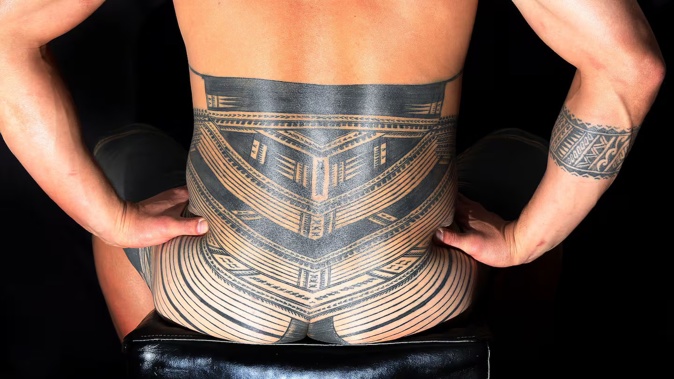
Tattoo-related injuries are behind hundreds of ACC claims every year, costing the country hundreds of thousands of dollars annually.
One woman told the Herald that her tattooist husband last month repaired the tattoos of a man who nearly had both legs amputated two years ago due to the severity of his post-tattoo infection.
So far this year, 484 new claims have been made for injuries where the accident description contained the words tattoo, ta moko and moko kauae.
Last year, there were 544 claims. No specific qualifications are required for tattoo artists in New Zealand.
Close call with amputation
Muliagatele Stella Taupau-Palea told the Herald that in September her husband, Auckland master tattooist Tulou’ena Mareko, had had to repair a traditional tatau gone wrong.
The man’s horror story began in 2023 when he travelled to Samoa to receive his pe’a (traditional tattoo), she said.
She said the man – whom the Herald has tried to contact – described deeper-than-usual cuts and excess blood, followed by serious infection.

The man self-discharged from a Samoan hospital after being told he would have to have both legs amputated due to the extent of his post-tattoo infection, Muliagatele said. Her husband fixed the man's tatau last month after he had completed a two-year recovery, she said. Image / Tulouena Mareko Tatau
He was admitted to Moto’otua Hospital near Apia and told by doctors that infection had spread into his blood and his legs would need to be amputated, she said.
The Samoa Observer reported that the man’s faulty tattoos were “incomplete and improperly done” by an unqualified tattooist, and were in need of corrective work.
“[He] escaped the hospital and went straight to the airport to catch the first flight out to Auckland,” Muliagatele said.
Samoan master tufuga Li'aifaiva Imo Levi has tattooed many famous Samoans, including Labour MP Carmel Sepuloni. Photo / Michael Craig
On arrival, an ambulance was waiting. Muliagatele said it then took the man two years to heal enough to seek a new tufuga – her husband – to complete his pe’a in South Auckland last month.
Customary tatau
Customary tatau, pe’a and malu, are considered a rite of passage and a source of pride for many Samoans, some of whom consider it both a physical and a spiritual process.
It can be gruelling and painful, involving tools traditionally made from bone and pigs’ tusks.

CJ Stowers proudly wears the traditional tatau of his forefathers. File photo / Stuart Munro
With each tap, blood is drawn: modern tattooing equipment is often frowned upon for pe’a and malu – the pain and stamina would not be the same.
For men, pe’a generally cover the abdomen, buttocks, lower back, and legs to below the knees.
The women’s equivalent, known as the malu, runs the length of a woman’s thighs to just below her knees.
Former Hurricanes player Lome Fa'atau shows off his pe'a. File Photo / Ross Setford
Samoans wearing the pe’a and malu include former heavyweight boxer To’aletai David Tua, rapper Scribe, former Hurricanes and Manu Samoa star Lome Fa’atau, ex-Silver Fern Sulu Fitzpatrick, and Labour MP Carmel Sepuloni, who was the Deputy Prime Minister when she received her malu tatau in 2023.
‘It’s scary: this is not unique’
Auckland Council and the Ministry of Health offer detailed customary tattooing guidelines, outlining what a tufuga (tattooist) must do before, during and after tattooing.
Deputy Prime Minister Carmel Sepuloni shows off her traditional Samoan tattoo, the malu. Photo / Michael Craig
They both stress the cleanliness of the work area. Ink containers should be one-use only, separate tools should be used on each client – and should be sterilised thoroughly.
Master tattooist Li’aifaiva Imo Levi is the tufuga of choice for many Samoans in New Zealand and Australia: he tattooed Tua and Sepuloni, as well as Sol3 Mio tenor Amitai Pati.
He told the Herald he too has had to step in and fix botched jobs, and stressed the need for people to choose their tattooist with care.
Tufuga master tattooist Li'aifaiva Imo Levi is encouraging people to do their research before choosing a tattooist. Photo / Michael Craig
“Your life is in that tufuga’s hands. You would want to place all your hopes and put all your trust in somebody whose morals and values align with yours.
“A lot of people look at the money,” he said, acknowledging cheaper options.
“But people have died. You can gain money again. But you can’t gain another life or another body.”
Carrying the shame

An Auckland man shows the traditional tattoo he received in Samoa that cost him two years of good health. Image / Tulouena Mareko Tatau
In the fa’asamoa, or Samoan culture, an incomplete pe’a – known as a pe’a mutu – carries a mark of deep and profound shame for the wearer and their family.
Muliagatele said when her husband finally finished the young man’s botched tatau, there were emotional scenes at the completion ceremony.
“It’s something that he’s lived with for two years. It’s not easy – the embarrassment and shame.”
She said the man told her how the unfinished tatau had weighed heavily on his mind and described the relief of that weight having been lifted.
Master tattooist Li’aifaiva told the Herald that even though the man’s tattoo might never look as attractive as other people’s, he should still wear it with pride.
He said it would remain a reminder of the pain, courage and resilience the man displayed to recover – and then persist to complete the tatau.
Vaimoana Mase is the Pasifika editor for the Herald’s Talanoa section, sharing stories from the Pacific community. She won junior reporter of the year at the then Qantas Media Awards in 2010 and won the best opinion writing award at the 2023 Voyager Media Awards.
Take your Radio, Podcasts and Music with you









